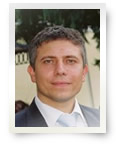|
Keynote 2: Cloudy Wheather for P2P, with a Chance of Gossip 
Prof. Alberto Montresor, University of Trento, Italy
 Abstract: Two of the Internet buzzwords of the the last decade, peer-to-peer (P2P) and cloud computing, hold similar promises: the (virtually) infinite availability of computing and storage resources. But there are important differences: the cloud provides you with highly-available resources, but at a cost; P2P resources are for free, but high level of churn can affect reliability. Will it be possible to mix the advantages of both worlds, exploiting the free resources of a P2P environment and reverting to the cloud whenever such resources are not sufficient to guarantee a minimum level of service? This talk tries to provide a positive answer. Abstract: Two of the Internet buzzwords of the the last decade, peer-to-peer (P2P) and cloud computing, hold similar promises: the (virtually) infinite availability of computing and storage resources. But there are important differences: the cloud provides you with highly-available resources, but at a cost; P2P resources are for free, but high level of churn can affect reliability. Will it be possible to mix the advantages of both worlds, exploiting the free resources of a P2P environment and reverting to the cloud whenever such resources are not sufficient to guarantee a minimum level of service? This talk tries to provide a positive answer.
Tutorial 2: Gossip Protocols for Large-Scale Distributed Systems 
Prof. Alberto Montresor, University of Trento, Italy
 Abstract: Gossip protocols were first proposed by Demers at al. in 1987, to solve the problem of disseminating information among replicated databases. Since then, gossip protocols have proven to be able to solve a large collection of problems in the field of large-scale distributed systems, ranging from distributed aggregation to topology management, from load balancing to function optimization, etc. In this tutorial, we will review the field of gossip-based computing, discussing their robustness, performance and security. Abstract: Gossip protocols were first proposed by Demers at al. in 1987, to solve the problem of disseminating information among replicated databases. Since then, gossip protocols have proven to be able to solve a large collection of problems in the field of large-scale distributed systems, ranging from distributed aggregation to topology management, from load balancing to function optimization, etc. In this tutorial, we will review the field of gossip-based computing, discussing their robustness, performance and security.
Keynote 3: Predictive IT Analytics 
Claudio Bartolini, HP Labs Palo Alto, USA
 Abstract: IT has become the fabric by which business is run. Yet decision makers in IT (from CIOs, IT executives, managers and practitioners), still rely on spreadsheet and heuristics to make most of their decisions. The aim of our research at HP Labs Palo Alto and Bristol is to provide decision support to IT decision makers by making sense of large masses of data available through disparate sources in IT. We apply data mining and operation research techniques (optimization, simulation, visualization) to the decision problems at hand, taking into account – and exploiting where possible – new trends such as social networking, collaboration technology and cloud computing. In this talk, after a brief intro to HP Labs, I’ll present current status and results, and future directions of our research in predictive IT analytics. Abstract: IT has become the fabric by which business is run. Yet decision makers in IT (from CIOs, IT executives, managers and practitioners), still rely on spreadsheet and heuristics to make most of their decisions. The aim of our research at HP Labs Palo Alto and Bristol is to provide decision support to IT decision makers by making sense of large masses of data available through disparate sources in IT. We apply data mining and operation research techniques (optimization, simulation, visualization) to the decision problems at hand, taking into account – and exploiting where possible – new trends such as social networking, collaboration technology and cloud computing. In this talk, after a brief intro to HP Labs, I’ll present current status and results, and future directions of our research in predictive IT analytics.
Tutorial 3: IT Service Management: Best Practices and Research Challenges 
Claudio Bartolini, HP Labs Palo Alto, USA
 Abstract: The importance and difficulty of managing IT resources and services is driving IT organizations to adopt best practices developed over the last few years. The paradigm being used to project IT to the enterprise and its clients, partners and suppliers is the "IT Service". The tutorial examines IT Service Management (ITSM) in its various aspects. The complete lifecycle of a service is covered, including service strategy, service design, service transition, service operation and continual service improvement. Best practices for service management are examined with the help of the very popular IT Infrastructure Library (ITIL) framework in its latest version (v3). Abstract: The importance and difficulty of managing IT resources and services is driving IT organizations to adopt best practices developed over the last few years. The paradigm being used to project IT to the enterprise and its clients, partners and suppliers is the "IT Service". The tutorial examines IT Service Management (ITSM) in its various aspects. The complete lifecycle of a service is covered, including service strategy, service design, service transition, service operation and continual service improvement. Best practices for service management are examined with the help of the very popular IT Infrastructure Library (ITIL) framework in its latest version (v3).
Research efforts in the emerging discipline of Business–driven IT management (BDIM) aim at managing enterprise IT infrastructure and services according to ITSM best practices, and at the same time at improving business results at the same time. BDIM is based on mappings between IT technical performance metrics and business relevant metrics and exploit the linkage to provide decision support to IT management so as to maximize business value and IT-Business alignment. As an example, the number of successfully executed IT infrastructure changes can be mapped to financial results due to the service disruption experienced by customers when the changes take place.
The first part of this tutorial covers the current state of ITIL and ITSM, briefly touching on another best practices framework: COBIT – Common Objectives for IT. The second part of the tutorial maps the state-of-the-art in BDIM resaerch. The tutorial will cover definitions of BDIM, challenges posed by IT-business alignment and will provide concrete application examples as well as a description of current BDIM tools available.
The tutorial provides a mix of practical aspects, recent research results and descriptions of real tools concerning ITSM and BDIM. The attendee will understand and appreciate the terms ITSM, ITIL, IT governance, COBIT, and will gain familiarity with important IT processes dealing with service design, service transition and service operation.
Short Course 1: Complex Networks in the Modeling of Computer Networks 
Authors
- Marcelo G. Almiron, Federal University of Alagoas, Brazil
- Heitor S. Ramos, Federal University of Alagoas, Brazil
- Eduardo M. Oliveira, Federal University of Minas Gerais, Brazil
- João G. M. de Menezes, Federal University of Minas Gerais, Brazil
- Daniel L. Guidoni, Federal University of Minas Gerais, Brazil
- Pedro O. Stancioli, Federal University of Minas Gerais, Brazil
- Felipe D. da Cunha, Federal University of Minas Gerais, Brazil
- André L. L. de Aquino, Federal University of Ouro Preto, Brazil
- Raquel A. F. Mini, Pontifical Catholic University of Minas Gerais, Brazil
- Alejandro C. Frery, Federal University of Alagoas, Brazil
- Antonio A. F. Loureiro, Federal University of Minas Gerais, Brazil
Short Course 2: Network Interconnection in the Future Internet: Challenges and Solutions 
Authors
- Miguel Elias Mitre Campista, Federal University of Rio de Janeiro, Brazil
- Lyno Henrique G. Ferraz, Federal University of Rio de Janeiro, Brazil
- Igor Monteiro Moraes, Federal University of Rio de Janeiro, Brazil
- Marcelo Luiz Drumond Lanza, Federal University of Rio de Janeiro, Brazil
- Luís Henrique M. K. Costa, Federal University of Rio de Janeiro, Brazil
- Otto Carlos Muniz Bandeira Duarte, Federal University of Rio de Janeiro, Brazil
Short Course 3: New Data Center Architectures for Cloud Computing 
Authors
- Fábio Luciano Verdi, Federal University of São Carlos, Brazil
- Christian Esteve Rothenberg, State University of Campinas, Brazil
- Rafael Pasquini, State University of Campinas, Brazil
- Maurício Ferreira Magalhães, State University of Campinas, Brazil
Short Course 4: Cognitive Networks: A New Paradigm for Wireless Communications 
Authors
- Marcelo Portela Sousa, Federal University of Campina Grande, Brazil
- Rafael Fernandes Lopes, Federal University of Campina Grande, Brazil, Federal Institute of Education, Science and Technology of Maranhão, Brazil
- Waslon Terllizzie Araújo Lopes, Federal University of Campina Grande, Brazil
- Marcelo Sampaio de Alencar, Federal University of Campina Grande, Brazil
Short Course 5: Underwater Sensor Networks 
Authors
- Luiz Filipe Menezes Vieira, Federal University of Minas Gerais, Brazil
- Antonio Alfredo Ferreira Loureiro, Federal University of Minas Gerais, Brazil
- Antônio O. Fernandes, Federal University of Minas Gerais, Brazil
- Mario Campos, Federal University of Minas Gerais, Brazil
|
